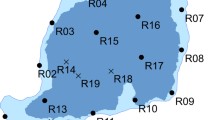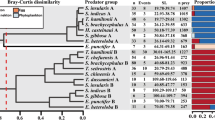Abstract
Intraspecific niche variation can differentially impact community processes and can represent the initial stages of adaptive radiation. Here we test for intraspecific differences in niche use in a keystone species, the alewife (Alosa pseudoharengus). To test whether feedbacks between predator foraging traits and prey communities have led to differences in niche use, we compare the diet composition and trophic position of anadromous and landlocked alewife populations. These populations differ in phenotypic traits related to foraging (gill raker spacing, gape width, and prey selectivity). Trait differences appear to have resulted from eco-evolutionary feedbacks between alewives and their zooplankton prey, and suggest that these two life history forms are exploiting different niches. Direct diets show that anadromous alewives consume a greater biomass of predatory copepods than do landlocked alewives. Anadromous alewives also consume more ostracods—a littoral prey item—as the growing season progresses. These diet differences do not translate into a significant difference in trophic position, as estimated from stable isotopes. However, stable-isotope estimates of diet source show that during early fall, anadromous alewives obtain significantly more of their dietary carbon from the littoral food web. This increased reliance on littoral prey is likely a result of a diet switch that occurs in response to the alewife-driven exhaustion of large-bodied prey items available in the pelagic zone, i.e., alewife niche construction. These findings show the existence of important intraspecific niche differences in the alewife and support the role of eco-evolutionary feedbacks in shaping these niche differences. The initiation of alewife divergence is the result of dam building by humans. Therefore, alewife niche differentiation can be considered to be an eco-evolutionary byproduct of human cultural niche construction.





Similar content being viewed by others
References
Albert AYK, Schluter D (2005) Selection and the origin of species. Curr Biol 15:R283–R288
Araújo MS, Guimarães PR Jr, Svanbåck R, Pinheiro A, Guimarães P, dos Reis SF, Bolnick DI (2008) Network analysis reveals contrasting effects of intraspecific competition on individual vs. population diets. Ecology 89:1981–1993
Bassar RD, Marshall MC, López-Sepulcre A, Zandonà E, Auer SK, Travis J et al (2010) Local adaptation in Trinidadian guppies alters ecosystem processes. Proc Natl Acad Sci USA 107:3616–3621
Bernatchez L, Chouinard A, Lu G (1999) Integrating molecular genetics and ecology in studies of adaptive radiation: whitefish, Coregnous sp., as a case study. Biol J Linn Soc 68:173–194
Brooks JL, Dodson SI (1965) Predation body size and composition of plankton. Science 150:28–35
Carpenter SR, Kitchell JF, Hodgson JR, Cochran PA, Elser MM et al (1987) Regulation of lake primary productivity by food web structure. Ecology 68:1863–1876
Dieckmann U, Doebeli M (1999) On the origin of species by sympatric speciation. Nature 400:354–357
Downing JA, Rigler FH (1984) A manual on methods for the assessment of secondary productivity in fresh waters. Blackwell, Oxford
Drenner RW, Strickler JR, O’Brien WJ (1978) Capture probability: the role of zooplankter escape in selective feeding of planktivorous fish. J Fish Res Board Can 35:1370–1373
Fry B, Arnold C (1982) Rapid C-13/C-12 turnover during growth of brown shrimp (Penaeus aztecus). Oecologia 54:200–204
Gavrilets S, Losos JB (2009) Adaptive radiation: contrasting theory with data. Science 323:732–737
Grant PR (1981) Speciation and the adaptive radiation of Darwin’s finches. Am Sci 69:653–663
Grant PR, Grant BR (2002) Adaptive radiation of Darwin’s finches. Am Sci 90:130–139
Grant PR, Grant BR (2006) Evolution of character displacement in Darwin’s finches. Science 313:224–226
Hairston NG, Ellner SP, Geber MA, Yoshida T, Fox JA (2005) Rapid evolution and the convergence of ecological and evolutionary time. Ecol Lett 8:1114–1127
Harmon LJ, Matthews B, Des Roches S, Chase JM, Shurin JB, Schluter D (2009) Evolutionary diversification in stickleback affects ecosystem functioning. Nature 458:1167–1170
Hesslein RH, Hallard KA, Ramlal P (1993) Replacement of sulfur, carbon, and nitrogen in tissue of growing broad whitefish (Coregonus nasus) in response to a change in diet traced by delta-S-34, delta-C-13 and delta-N-15. Can J Fish Aquat Sci 50:2071–2076
Jurgens K, Matz C (2002) Predation as a shaping force for the phenotypic and genotypic composition of planktonic bacteria. Anton Leeuw Int J G Mol Microbiol 81:413–434
Kitchell JF, Eby LA, He X, Schindler DE, Wright RA (1994) Predator–prey dynamics in an ecosystem context. J Fish Biol 45(Suppl):S209–S226
Laland KN, Odling-Smee FJ, Feldman MW (2001) Cultural niche construction and human evolution. J Evol Biol 14:22–33
Langerhans RB, Knouft JH, Losos JB (2006) Shared and unique features of diversification in greater Antillean Anolis ecomorphs. Evolution 60:362–369
Losos JB, Jackman TR, Larson A, de Queiroz K, Rodriguez-Schettino L (1998) Contingency and determinism in replicated adaptive radiations of island lizards. Science 279:2115–2118
Losos JB, Glor RE, Kolbe JJ, Nicholson K (2006) Adaptation, speciation, and convergence: a hierarchical analysis of adaptive radiation in Caribbean Anolis lizards. Ann Mo Bot Gard 93:24–33
McKinnon JS, Mori S, Blackman BK, David L, Kingsley DM, Jamieson L, Chou J, Schluter D (2004) Evidence for ecology’s role in speciation. Nature 429:294–298
Meyer A, Kocher TD, Basasibwaki P, Wilson AC (1990) Monophyletic origin of Lake Victoria cichlid fishes suggested by mitochondrial-DNA sequences. Nature 347:550–553
Mills EL, Ogorman R, Degisi J, Heberger RF, House RA (1992) Food of the alewife (Alosa pseudoharengus) in Lake Ontario before and after the establishment of Bythotrephes cederstroemi. Can J Fish Aquat Sci 49:2009–2019
Mills EL, Ogorman R, Roseman EF, Adams C, Owens RW (1995) Planktivory by alewife (Alosa pseudoharengus) and rainbow smelt (Osmerus mordax) on microcrustacean zooplankton and dreissenid (Bivalvia: Dreissenidae) veligers in southern Lake Ontario. Can J Fish Aquat Sci 52:925–935
Odling-Smee FJ, Laland KN, Feldman MW (1996) Niche construction. Am Nat 147:641–648
Odling-Smee FJ, Laland KN, Feldman MW (2003) Niche construction: the neglected process in evolution. Princeton University Press, Princeton
Paine RT (1966) Food web complexity and species diversity. Am Nat 100:65–75
Palkovacs EP, Post DM (2008) Eco-evolutionary interactions between predators and prey: can predator-induced changes to prey communities feed back to shape predator foraging traits? Evol Ecol Res 10:699–720
Palkovacs EP, Post DM (2009) Experimental evidence that phenotypic divergence in predators drives community divergence in prey. Ecology 90:300–305
Palkovacs EP, Dion KB, Post DM, Caccone A (2008) Independent evolutionary origins of landlocked alewife populations and rapid parallel evolution of phenotypic traits. Mol Ecol 17:582–597
Palkovacs EP, Kinnison MT, Correa C, Dalton CM, Hendry AP (2012) Fates beyond traits: ecological consequences of human-induced trait change. Evol Appl 5:183–191
Persson L, Greenberg LA (1990) Optimal foraging and habitat shift in perch (Perca fluviatilis) in a resource gradient. Ecology 71:1699–1713
Post DM (2002) Using stable isotopes to estimate trophic position: models, methods, and assumptions. Ecology 83:703–718
Post DM, Palkovacs EP (2009) Eco-evolutionary feedbacks in community and ecosystem ecology: interactions between the ecological theater and the evolutionary play. Phil Trans R Soc B 364:1629–1640
Post DM, Layman CA, Arrington DA, Takimoto G, Quattrochi J, Montana CG (2007) Getting to the fat of the matter: models, methods and assumptions for dealing with lipids in stable isotope analyses. Oecologia 152:179–189
Post DM, Palkovacs EP, Schielke EG, Dodson SI (2008) Intraspecific variation in a predator affects community structure and cascading trophic interactions. Ecology 98:2019–2032
Pothoven SA, Vanderploeg HA (2004) Diet and prey selection of alewives in Lake Michigan: seasonal, depth, and interannual patterns. Trans Am Fish Soc 133:1068–1077
Schluter D (1996) Ecological causes of adaptive radiation. Am Nat 148(Suppl):S40–S64
Schluter D (2001) Ecology and the origin of species. Trends Ecol Evol 16:372–380
Seehausen O (2009) Speciation affects ecosystems. Nature 458:1122–1123
Sternberg D, Balcombe S, Marshall J, Lobegeiger J (2008) Food resource variability in an Australian dryland river: evidence from the diet of two generalist native fish species. Mar Freshwater Res 59:137–144
Stone HH, Jessop BM (1994) Feeding habits of anadromous alewives, Alosa pseudoharengus, off the Atlantic Coast of Nova Scotia. Fish Bull 92:157–170
Svanback R, Bolnick DI (2007) Intraspecific competition drives increased resource use diversity within a natural population. Proc R Soc B 274:839–844
Wahlstrom E, Persson L, Diehl S, Bystrom P (2000) Size-dependent foraging efficiency, cannibalism and zooplankton community structure. Oecologia 123:138–148
Walsh MR, Post DM (2011) Interpopulation variation in a fish predator drives evolutionary divergence in prey in lakes. Proc R Soc B 278:2628–2637
Walsh MR, Post DM (2012) The impact of intraspecific variation in a fish predator on the evolution of phenotypic plasticity and investment in sex in Daphnia ambigua. J Evol Biol 25:80–89
Whitlock R, Grime JP, Burke T (2010) Genetic variation in plant morphology contributes to the species-level structure of grassland communities. Ecology 91:1344–1354
Williams EE (1983) Ecomorphs, faunas, island size, and diverse end points in island radiations of Anolis. In: Huey RB, Pianka ER, Schoener TW (eds) Lizard ecology: studies of a model organism. Harvard University Press, Cambridge, MA, pp 326–370
Yoshida T, Jones LE, Ellner SP, Fussmann GF, Hairston NG (2003) Rapid evolution drives ecological dynamics in a predator–prey system. Nature 424:303–306
Acknowledgments
We thank Christopher Dalton, Rachel Doud, and Beth Kochin for help in the field, and Cynthia Winkworth for help in the field and lab. We also thank Gerard Olack in the Yale University Earth System Center for Stable Isotope Studies for assistance with stable-isotope analysis. Funding was provided by the USA National Science Foundation (to DMP; DEB No. 0717265), the Connecticut Institute for Water Resources (to DMP), an EPA STAR Graduate Fellowship Award (to EPP), the Yale University John F. Enders Fellowship (to EGS), the Yale Department of Ecology and Evolutionary Biology Chairman’s Discretionary Fund (to EGS and EPP), and the Yale Institute for Biospheric Studies Center for Field Ecology (to EGS).
Author information
Authors and Affiliations
Corresponding author
Rights and permissions
About this article
Cite this article
Schielke, E.G., Palkovacs, E.P. & Post, D.M. Eco-Evolutionary Feedbacks Drive Niche Differentiation in the Alewife. Biol Theory 6, 211–219 (2011). https://doi.org/10.1007/s13752-012-0031-9
Received:
Accepted:
Published:
Issue Date:
DOI: https://doi.org/10.1007/s13752-012-0031-9




